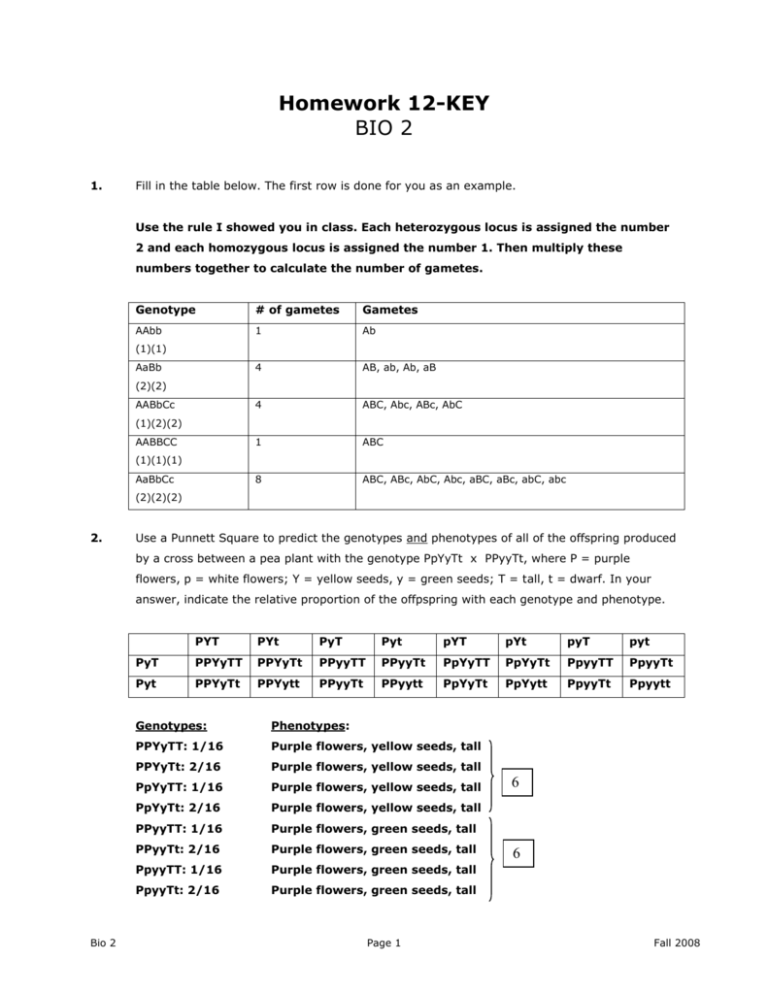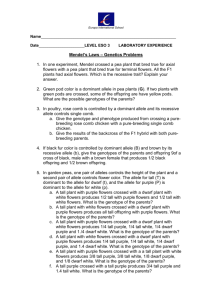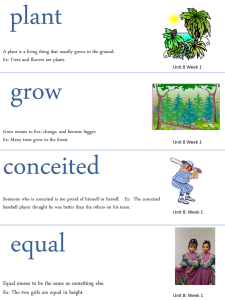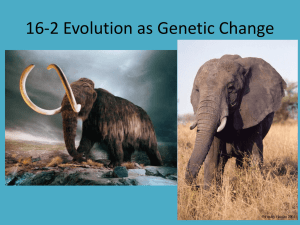Homework 12 KEY
advertisement

Homework 12-KEY BIO 2 1. Fill in the table below. The first row is done for you as an example. Use the rule I showed you in class. Each heterozygous locus is assigned the number 2 and each homozygous locus is assigned the number 1. Then multiply these numbers together to calculate the number of gametes. Genotype # of gametes Gametes AAbb 1 Ab 4 AB, ab, Ab, aB 4 ABC, Abc, ABc, AbC 1 ABC 8 ABC, ABc, AbC, Abc, aBC, aBc, abC, abc (1)(1) AaBb (2)(2) AABbCc (1)(2)(2) AABBCC (1)(1)(1) AaBbCc (2)(2)(2) 2. Use a Punnett Square to predict the genotypes and phenotypes of all of the offspring produced by a cross between a pea plant with the genotype PpYyTt x PPyyTt, where P = purple flowers, p = white flowers; Y = yellow seeds, y = green seeds; T = tall, t = dwarf. In your answer, indicate the relative proportion of the offpspring with each genotype and phenotype. Bio 2 PYT PYt PyT Pyt pYT pYt pyT pyt PyT PPYyTT PPYyTt PPyyTT PPyyTt PpYyTT PpYyTt PpyyTT PpyyTt Pyt PPYyTt PPYytt PPyyTt PPyytt PpYyTt PpYytt PpyyTt Ppyytt Genotypes: Phenotypes: PPYyTT: 1/16 Purple flowers, yellow seeds, tall PPYyTt: 2/16 Purple flowers, yellow seeds, tall PpYyTT: 1/16 Purple flowers, yellow seeds, tall PpYyTt: 2/16 Purple flowers, yellow seeds, tall PPyyTT: 1/16 Purple flowers, green seeds, tall PPyyTt: 2/16 Purple flowers, green seeds, tall PpyyTT: 1/16 Purple flowers, green seeds, tall PpyyTt: 2/16 Purple flowers, green seeds, tall Page 1 6 6 Fall 2008 PPYytt: 1/16 Purple flowers, yellow seeds, short PpYytt: 1/16 Purple flowers, yellow seeds, short PPyytt: 1/16 Purple flowers, green seeds, short Ppyytt: 1/16 Purple flowers, green seeds, short 2 2 The phenotypes can be quickly confirmed using the multiplication rule: Purple flowers, yellow seeds, tall (P_Y_T_) = (1)(1/2)(3/4) = 6/16 Purple flowers, green seeds, tall (P_yyT_) = (1)(1/2)(3/4) = 6/16 Purple flowers, yellow seeds, short (P_Y_tt) = (1)(1/2)(1/4) = 2/16 Purple flowers, green seeds, short (P_yytt) = (1)(1/2)(1/4) = 2/16 3. Use the multiplication rule to calculate the fraction of offspring from a cross between AaBbCcDd and AaBbCcDd that would have the same phenotype as the two parents. A_B_C_D_ = (3/4)(3/4)(3/4)(3/4) = 81/256 4. Use the multiplication and addition rules to calculate the probability that a couple who plans to have 4 children will have two boys and two girls (any order). Assume that the couple will succeed in having exactly four children. There are 6 possible orders. Each order has a probability of 1/16 (as shown for the first possibility) since the chance of either sex in any given pregnancy is ½ and the pregnancies are independent events. GGBB = (1/2)(1/2)(1/2)(1/2) = 1/16 BBGG = (1/2)(1/2)(1/2)(1/2) = 1/16 GBGB = (1/2)(1/2)(1/2)(1/2) = 1/16 BGBG = (1/2)(1/2)(1/2)(1/2) = 1/16 BGGB = (1/2)(1/2)(1/2)(1/2) = 1/16 GBBG = (1/2)(1/2)(1/2)(1/2) = 1/16 The total probability therefore = (1/16 x 6 ) = 6/16 5. About 1 in 25 Ashkenazai Jews are carriers (heterozygotes) for the autosomal recessive allele that causes Tay Sachs Disease. Bio 2 Page 2 Fall 2008 a. If two Ashkenazi Jews who have no family history of the disease decide to have children, what is the probability that their first child will have sickle cell anemia? Indicate how you arrived at your answer. (1/25) = probability man is a carrier (1/25) = probability woman is a carrier (1/4) = probability two carriers’ first child will be affected All of these events are independent of each other and all must be true for the child to be affected. Therefore, the combined probability is: (1/25)(1/25)(1/4) = 1/2500 b. If the couple’s first child is affected with the disease, what is the probability that their second child will also be affected? Indicate how you arrived at your answer. (1) = probability man is a carrier (1) = probability woman is a carrier (1/4) = probability two carriers’ first child will be affected (1)(1)(1/4) = 1/4 c. If, after having one diseased child, the couple decides to have 3 more children, what is the probability that at least one of the additional 3 children will also have Tay Sachs? Indicate how you arrived at your answer. (Use the space at the top of the next page for your answer.) For at least one child to be affected, the following probabilities exist: AAA = (1/4)(1/4)(1/4) = 1/64 (all children affected) AAN = (1/4)(1/4)(3/4) = 3/64 (first two affected, third normal) ANA = (1/4)(3/4)(1/4) = 3/64 (first and third affected, second normal) NAA = (3/4)(1/4)(1/4) = 3/64 (first normal, second and third affected ANN = (1/4)(3/4)(3/4) = 9/64 (first affected, second and third normal) NAN = (3/4)(1/4)(3/4) = 9/64 (first and third normal, second affected) NNA = (3/4)(3/4)(1/4) = 9/64 (first two normal, third affected) The probability of any one of these mutually exclusive events occurring is the sum of their individual probabilities = 37/64 Bio 2 Page 3 Fall 2008 Note that the opposite of having at least one child affected is having no children affected. So an easier way to approach this problem is to calculate the probability that none of the 3 children will be affected and subtract this number from 1. NNN = (3/4)(3/4)(3/4) = 27/64 64/64 – 27/64 = 37/64 5. X-linked dominant disease mutations are rare in humans, but some have been reported. One such disease, hypertrichosis, causes excessive hair growth (all over the body, especially on the face and hands). If a man with hypertrichosis has 6 girls and 2 boys with his unaffected wife, how many of the children will be affected? What will the sex of the affected children be? How can you tell? Indicate how you arrived at your answer, using a Punnett Square. XH= hypertrichosis (dominant); Xh= normal Xh XH Y XHXh XhY All of the daughters will be affected because the disease is dominant and they will all inherit their father’s affected X chromosome. None of the sons will be affected because they inherit Y, not X, from their fathers. 6. Jane has type A blood and is married to Andy, who has type B blood. Their first child, Steven, has type A blood and their second child, Maury, has type B blood. a. What are the genotypes of Jane and Andy at the ABO blood locus? (Assume that Andy is the biological father of both children and indicate how you arrived at your answer.) Jane must be IAi and Andy must be IBi. Jane passed her IA allele to Steven and Andy passed his i allele, which explains why Steven has Type A blood. Jane passed her i allele to Maury and Andy passed his IB allele, which explains why Maury has Type B blood. If Jane was IAIA she could not have had a child with Type B blood. If Andy was IBIB he could not have had a child with Type A blood. b. If the couple has additional children, could one of the children have a blood type that would prove that Andy was not the father? Explain. Bio 2 Page 4 Fall 2008 In this family, no. All genotypes are possible: 7. IA i IB IAIB (Type AB) IBi (Type B) i IAi (Type A) ii (Type O) Gabriella is 29 and her mother died of Huntington Disease, an autosomal dominant neurological genetic disorder that has a late onset (about age 45). Gabriella does not want genetic testing to see if she has the disease allele. However, she has two young daughters. What is the probability that one (but not both) of the girls carry the disease allele? Indicate how you arrived at your answer. Assume that Gabriella’s husband does not carry the allele. Gabriella has a ½ chance of having the disease allele. If she is a carrier, there are two ways that one (but not both) of her daughters could have the allele: AN and NA. Each of these has a ¼ chance, and they are mutually exclusive, with a combined probability of ½. Probability Gabriella has the allele = ½ Probability one (but not both) of her daughters got the allele if she carries it: ½ Overall probability that one (but not both) of her daughters has the allele: (1/2(1/2) = 1/4 8. Gerard and Kate are both carriers for a recessive disease allele that causes Fanconi’s anemia, a severe form of anemia that is usually fatal in childhood. The couple wants to start a family with 4 children and have asked their genetic counselor to predict the probabilities of each of the following outcomes. a. All four children are affected. (1/4)(1/4)(1/4)(1/4) = 1/256 b. Only one of the four children is affected. Possible orders: NNNA, NNAN, NANN, ANNN, each with a probability of (1/4)(3/4)3 = 27/256. Total probability is (4)(27/256) = 108/256 Bio 2 Page 5 Fall 2008 c. Two of the four children are affected. Possible orders: AANN, NNAA, ANAN, NANA, NAAN, ANNA, each with a probability of (1/4)2(3/4)2 = 9/256. Total probability is (6)(9/256) = 54/256 d. Three of the four children are affected. Possible orders: AAAN, AANA, ANAA, NAAA, with each order having a probability of (1/4)3(3/4) = 3/256. Total probability is (4)(3/256) = 12/256 e. None of the children is affected. NNNN = (3/4)4 =81/256 f. Add up all the probabilities you calculated for a-e. Do they add up to 1? 1/256 + 108/256 + 54/256 + 12/256 + 81/256 = 256/256 = 1 Note that the most probable outcome for this couple is that 1 in 4 of their children will be affected. This makes sense since the statistical probability is 1 in 4 for each pregnancy. Bio 2 Page 6 Fall 2008









